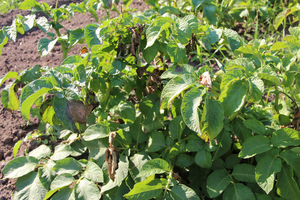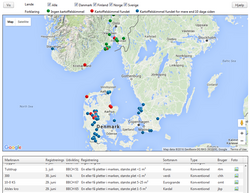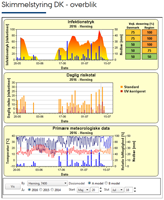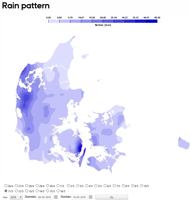Denmark - Blight Management
Introduction

BLIGHT MANAGEMENT is operated by the Aarhus University (AU), the Danish Agricultural Advisory Service (SEGES) and the Danish Meteorological Institute (DMI). It integrates all available information about late blight control, including tools like surveillance of early attacks, weather based late blight infection pressure, regional precipitation during crop emergence (risk of oospores), the negative prognosis for risk of infection from infected tubers, mapping tool for weather based risk hot spot analysis, general weather information and -forecast, fungicide information etc. The infection pressure, monitoring information and crop susceptibility is converted into a decision model called the “Dose model”. Below is a description of the Danish Blight Management system- how it works in practice:
- During crop emergence “risk fields” are identified and inspected for attacks from oospores. Risk fields are fields with narrow crop rotations where oospores might be present. If it rains and the infection pressure is medium to high then the risk is higher for oospore driven infections. Interactive GIS maps for precipitation and infection pressure is available as well as local calculations of rain and infection pressure
- Early attacks are reported via the Nordic Surveillance system that has been operational since 2010. Recently all Nordic countries started to use the BlightTracker smartphone APP for uploading of recordings of early attacks of late blight (Hansen et al., 2015)
- A network of potato advisors (7-8) meet every Monday morning for a telephone meeting to inform each other and exchange ideas and views of the regional and local situation re blight risk and when and how control actions should start. In this situation the regional maps are very useful. We also include information from other national surveillance systems used in our neighbouring countries – ISIP for Germany, Fight against Blight for the UK and information from the Netherlands. If blight is early in these countries this is a warning for us in Denmark. The regional potato advisors are a very important dissemination channel for late blight advice, because not every grower look at the internet about alerts.
- When blight has been found in a region it is evaluated if this is very local attack in a special field, or due to oospores and also about the weather based blight risk in the forthcoming week. If the forecast says blight weather a majority of farmers in this region (distance 25-50 KM) will start control actions – in more resistance cultivars with reduced dosages.
- When late blight is established in the region (> 5 conventional fields reported in the Surveillance system) then a majority of farmers spray according to the Blight Management System – Dose Model. As a thumb rule: spray weekly with low dosage contact fungicide when blight weather is unfavourable and full dosage during high infection pressure. When blight is widespread and epidemics are observed in organic potatoes (or untreated plots) this will indicate that the spore loads will increase. Next time a high infection pressure is indicated in the forecast then many farmers will use a stronger (expensive) compound with systemic effect. Stronger compounds are also used if the spray is too late compared to an important infection risk.
- With climate change we have seen a tendency to more extreme weather including some periods with very heavy new growth. Also long periods with dry weather. When rains come again after a drought spell heavy new growth can happen. During those periods farmers have experienced that a 7 days spray schedule too long and 5 days interval is needed to control blight. This kind of decision making is not included in the Blight Management system, and this is decisions to be taken by the advisor and the farmer together.
- If a field is attacked with blight more than a few lesions here and there (>0,5%), then it is not recommended to use reduced dosages. Blight Management is then only of minor use because new infections can happen from rain splash via rain events alone. This is not included in the system. Very often a dry weather spell and intensive chemical control can eradicate a minor attack.
- In 2018 we test an updated version of blight management for use in new and more resistante cultivars for starch production. We include observation in the IPMBlight2.0 trap nurseries including a 20 differential set. We also sample early p.infestans isolates to be tested at JHI. If we can get results in 14 days, this will then influence fungicide choice based on knowledge on the link between genotype and fungicide resistance.



